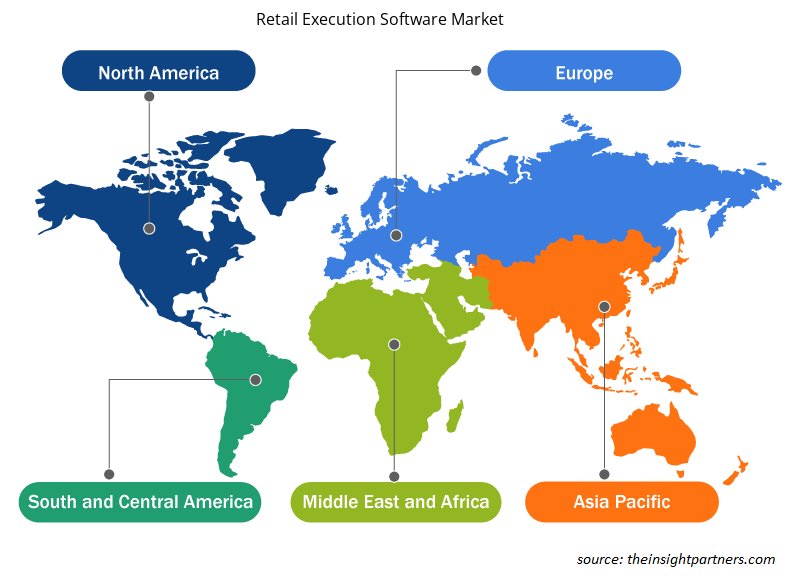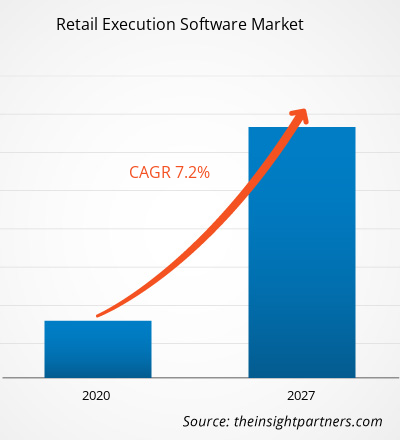Nel 2019, il mercato del software per l'esecuzione al dettaglio è stato valutato 198,39 milioni di dollari USA e si prevede che raggiungerà i 303,26 milioni di dollari USA entro il 2027; si prevede una crescita a un CAGR del 7,2% dal 2020 al 2027.
Il mercato globale del software di esecuzione al dettaglio sta assistendo a una crescita sostanziale dovuta alla crescente preferenza delle piattaforme di vendita al dettaglio e di e-commerce e alla crescente integrazione dei gateway di pagamento con il software di esecuzione al dettaglio. In base alla geografia, il Nord America ha guidato il mercato con una quota di fatturato del 31,13%, seguita da Europa e APAC. La presenza di un'economia in rapida crescita, la crescente adozione di tecnologie automatizzate, la crescente penetrazione di Internet e l'enorme adozione di software da parte degli utenti finali sono tra i principali fattori che dovrebbero guidare la crescita del mercato del software di esecuzione al dettaglio in queste regioni. Si prevede che il mercato del software di esecuzione al dettaglio in APAC crescerà al CAGR più elevato durante il periodo di previsione. La crescente adozione di tecnologie avanzate nel settore della vendita al dettaglio guida il tasso di adozione del software di esecuzione al dettaglio. Le aziende investono in software per semplificare le loro operazioni aziendali. In APAC, i mercati in più rapida crescita per la vendita al dettaglio e l'e-commerce sono India e Cina. I consumatori di questi paesi sono altamente inclini allo shopping online a causa della crescente penetrazione di Internet e le tendenze dello shopping online stanno trasformando diverse aree della vendita al dettaglio e dell'e-commerce nella regione. Pertanto, questi fattori stanno spingendo la crescita del mercato del software di esecuzione al dettaglio nell'APAC. Anche altre regioni in via di sviluppo, come MEA e SAM, sono destinate a crescere a un ritmo costante grazie alle crescenti iniziative governative per digitalizzare l'economia con l'adozione di tecnologie avanzate.
Personalizza questo report in base alle tue esigenze
Riceverai la personalizzazione gratuita di qualsiasi report, comprese parti di questo report, o analisi a livello nazionale, pacchetto dati Excel, oltre a usufruire di grandi offerte e sconti per start-up e università
- Scopri le principali tendenze di mercato in questo rapporto.Questo campione GRATUITO includerà analisi di dati che spaziano dalle tendenze di mercato alle stime e alle previsioni.
Impatto della pandemia di COVID-19 sul mercato del software di esecuzione al dettaglio
Secondo l'ultimo rapporto dell'Organizzazione Mondiale della Sanità (OMS), Stati Uniti, Spagna, Italia, Francia, Germania, Regno Unito, Russia, Turchia, Brasile, Iran e Cina sono tra i paesi più colpiti dall'epidemia di COVID-19. La crisi sta influenzando negativamente le industrie in tutto il mondo. L'economia globale ha subito il colpo peggiore nel 2020 e probabilmente continuerà anche nel 2021. L'epidemia ha creato notevoli sconvolgimenti nei settori primari come logistica, vendita al dettaglio ed e-commerce. Il forte calo del settore della logistica internazionale sta frenando la crescita del mercato globale del software di esecuzione al dettaglio.
Approfondimenti sul mercato del software di esecuzione al dettaglio
Aumento dell'integrazione dei gateway di pagamento con il software di esecuzione al dettaglio
Alimenta la crescita del mercato del software di esecuzione al dettaglio
I pagamenti online sono relativamente popolari nell'area APAC, poiché la maggior parte dei consumatori utilizza i dispositivi mobili per pagare i beni. Diverse opzioni di pagamento elettronico popolari sono utilizzate per gli acquisti digitali mobili in paesi come Corea del Sud, Giappone, Singapore e Australia. Le aziende di gateway di pagamento in questi paesi offrono soluzioni di pagamento elettronico complete a vari fornitori di software di esecuzione al dettaglio per cavalcare l'onda dello sviluppo tecnologico. Inoltre, la crescita del mercato è attribuita ai progressi nella tecnologia dei gateway di pagamento e all'aumento dell'uso dei portafogli mobili. Si prevede che la crescente integrazione dei sistemi di gateway di pagamento con il software di esecuzione al dettaglio e l'aumento degli acquisti online, insieme ai progressi nei metodi di fatturazione, alimenteranno ulteriormente la domanda di software di esecuzione al dettaglio durante il periodo di previsione.
Approfondimenti di mercato basati sulle dimensioni aziendali
In base alle dimensioni aziendali, il mercato del software di esecuzione al dettaglio è diviso in grandi aziende e PMI. Nel 2019, il segmento delle grandi aziende ha rappresentato una quota significativa del mercato. Tuttavia, si prevede che il segmento delle PMI registrerà un CAGR significativo durante il periodo di previsione.
Approfondimenti di mercato basati sulle applicazioni
In base all'applicazione, il mercato del software di esecuzione al dettaglio è segmentato in operazioni al dettaglio, gestione del servizio sul campo, automazione dei moduli mobili, vendite sul campo, gestione delle promozioni commerciali, coinvolgimento dei dipendenti e altri. Nel 2019, il segmento delle operazioni al dettaglio ha rappresentato una quota significativa del mercato. Le operazioni al dettaglio riguardano la gestione di individui, catena di fornitura, layout del negozio, operazioni di cassa, inventario fisico e gestione di dati master, promozioni e prezzi. Il software di esecuzione al dettaglio per le operazioni al dettaglio fornisce ai negozi al dettaglio fisici strumenti per sfruttare le loro informazioni attuali e sfruttarle in un modo che avvantaggi la loro attività.
Le aziende sono fortemente impegnate nello sviluppo di nuovi prodotti per ottenere trazione nel mercato del software di esecuzione al dettaglio. Ad esempio, Salesforce ha lanciato un nuovo prodotto di settore, vale a dire Consumer Goods Cloud, che consente alle aziende di beni di consumo di alimentare la crescita dei ricavi e aumentare il ROI attraverso capacità di esecuzione al dettaglio migliorate. Di seguito sono elencati alcuni sviluppi da parte di attori chiave:
2020: StayinFront, Inc. retail data insight (RDI) ha esteso la sua partnership con Field Sales Solutions per analisi in tempo reale. La vista sul campo e la vista ROI di StayinFront RDI forniscono informazioni fruibili ai team di vendita sul campo. I servizi facilitano e massimizzano l'efficacia in negozio, consentendo ai clienti di Field Sales Solutions di fare di più, sapere di più e vendere di più.
2018: Intelligence Retail si è rivolta a IBM per migliorare la sua offerta principale e consentire ai suoi clienti di trarre vantaggio dal monitoraggio degli indicatori chiave di audit del negozio in tempo reale. Un nuovo modulo analitico della soluzione Intelligence Retail, basato sulle tecnologie IBM Watson Analytics integrate, è progettato per aiutare a monitorare efficacemente gli indicatori chiave dell'audit al dettaglio elaborando in tempo reale i big data, tra cui la disponibilità di beni sullo scaffale, la quota di scaffale, i prezzi e le promozioni
Approfondimenti regionali sul mercato del software di esecuzione al dettaglio
Le tendenze regionali e i fattori che influenzano il mercato del software di esecuzione al dettaglio durante il periodo di previsione sono stati ampiamente spiegati dagli analisti di Insight Partners. Questa sezione discute anche i segmenti e la geografia del mercato del software di esecuzione al dettaglio in Nord America, Europa, Asia Pacifico, Medio Oriente e Africa e America meridionale e centrale.

- Ottieni i dati specifici regionali per il mercato del software di esecuzione al dettaglio
Ambito del rapporto di mercato sul software di esecuzione al dettaglio
| Attributo del report | Dettagli |
|---|---|
| Dimensioni del mercato nel 2019 | 198,39 milioni di dollari USA |
| Dimensioni del mercato entro il 2027 | 303,26 milioni di dollari USA |
| CAGR globale (2019 - 2027) | 7,2% |
| Dati storici | 2017-2018 |
| Periodo di previsione | 2020-2027 |
| Segmenti coperti | Per dimensione aziendale
|
| Regioni e Paesi coperti | America del Nord
|
| Leader di mercato e profili aziendali chiave |
|
Densità dei player del mercato del software di esecuzione al dettaglio: comprendere il suo impatto sulle dinamiche aziendali
Il mercato del software di esecuzione al dettaglio sta crescendo rapidamente, spinto dalla crescente domanda degli utenti finali dovuta a fattori quali l'evoluzione delle preferenze dei consumatori, i progressi tecnologici e una maggiore consapevolezza dei vantaggi del prodotto. Con l'aumento della domanda, le aziende stanno ampliando le loro offerte, innovando per soddisfare le esigenze dei consumatori e capitalizzando sulle tendenze emergenti, il che alimenta ulteriormente la crescita del mercato.
La densità degli operatori di mercato si riferisce alla distribuzione di aziende o società che operano in un particolare mercato o settore. Indica quanti concorrenti (operatori di mercato) sono presenti in un dato spazio di mercato in relazione alle sue dimensioni o al valore di mercato totale.
Le principali aziende che operano nel mercato del software di esecuzione al dettaglio sono:
- Bizom (Mobisy Technologies Private Limited)
- EdgeCG (StayinFront, Inc.),
- Intelligenza al dettaglio
- Mobisoft
- Sonda POP
Disclaimer : le aziende elencate sopra non sono classificate secondo un ordine particolare.

- Ottieni una panoramica dei principali attori del mercato del software di esecuzione al dettaglio
Per dimensione aziendale
- Grandi Imprese
- PMI
Per applicazione
- Operazioni di vendita al dettaglio
- Gestione del servizio sul campo
- Automazione dei moduli mobili
- Vendite sul campo
- Gestione della promozione commerciale
- Coinvolgimento dei dipendenti
- Altri
Per Geografia
America del Nord
- NOI
- Canada
- Messico
Europa
- Francia
- Germania
- Italia
- Regno Unito
- Russia
- Resto d'Europa
Asia Pacifico (APAC)
- Cina
- India
- Corea del Sud
- Giappone
- Australia
- Resto dell'APAC
Medio Oriente e Africa (MEA)
- Sudafrica
- Arabia Saudita
- Emirati Arabi Uniti
- Resto del MEA
America del Sud (SAM)
- Brasile
- Argentina
- Resto del SAM
Profili aziendali
- Bizom (Mobisy Technologies Private Limited)
- Servizi di hosting di terze parti (Store.com)
- Intelligenza al dettaglio
- Mobisoft
- Sonda POP
- Spring Mobile Solutions, Inc.
- Società a responsabilità limitata
- Valomnia
- VINCERE
- Gruppo Kantar
- Analisi storica (2 anni), anno base, previsione (7 anni) con CAGR
- Analisi PEST e SWOT
- Valore/volume delle dimensioni del mercato - Globale, regionale, nazionale
- Industria e panorama competitivo
- Set di dati Excel


- Hair Wig Market
- Architecture Software Market
- Biopharmaceutical Contract Manufacturing Market
- Aircraft Wire and Cable Market
- Joint Pain Injection Market
- Advanced Planning and Scheduling Software Market
- Broth Market
- Artificial Intelligence in Healthcare Diagnosis Market
- Equipment Rental Software Market
- High Speed Cable Market

Report Coverage
Revenue forecast, Company Analysis, Industry landscape, Growth factors, and Trends

Segment Covered
This text is related
to segments covered.

Regional Scope
North America, Europe, Asia Pacific, Middle East & Africa, South & Central America

Country Scope
This text is related
to country scope.
Domande frequenti
The retail operations segment led the retail execution software market with a market share of 33.3% in 2019. Further, it is expected to garner 30.9% share by 2027. Retail operations involves the management of individuals, supply chain, store layout, cash operations, physical inventory, and management of master data, promotions and pricing, etc. Retail execution software for retail operations equips brick-and-mortar retail stores with tools to take advantage of their current information and leverage it in a way that benefits their business. This information is often obtained from POS systems, retail management systems, and other retail use software daily. This information is taken and analyzed by the retail operations platform, providing managers and business owners with usable insights. Pricing, inventory management, or store layout can be the focus of these insights. The objective is to optimize a store user data that the store is already collecting for maximum sales. Retail operations may be integrated to manage retail POS software, retail management systems, or retail task management software.
North America dominated the retail execution software market in 2019 with a share of 31.1%; and is expected to lose its market share during the forecast period. APAC is anticipated to hold the largest market share by 2027, followed by North America and Europe. APAC is anticipated to grow at the highest CAGR during the forecast period. The region comprises prime nations such as China, India, Japan, South Korea, and Australia. Rising adoption of advanced technologies in the retail industry is drives the adoption rate of retail execution software. Companies invest in software to streamline their business operations.
The retail and e-commerce industry provides a huge platform for shopping. It is increasing at an unprecedented rate across the globe. Retail and e-commerce platforms also help various businesses to reach their customers easily; hence, necessary exposure to business is achieved. According to the Census Bureau of the Department of Commerce, US retail e-commerce sales were US$ 160.3 billion for the first quarter of 2020, an increase of 2.4% from the fourth quarter of 2019. Growing retail and e-commerce industries in APAC and North America are thriving in the business for retail execution software. The retail execution software is used for planning, managing, and monitoring the in-store activities in the consumer packaged goods (CPG) industry—such as retail operations, field sales, trade promotion management, field service management, mobile forms automation, and employee engagement. These software facilitate to enhance the collaboration between CPG companies and retailers to increase profits and optimize in-store sales. This factor is scaling up the retail execution software market size year-on-year.
Trends and growth analysis reports related to Technology, Media and Telecommunications : READ MORE..
The List of Companies - Retail Execution Software Market
- Bizom (Mobisy Technologies Private Limited)
- EdgeCG (StayinFront, Inc.),
- Intelligence Retail
- Mobisoft
- POPProbe
- Spring Mobile Solutions, Inc.
- Trax Technology Solutions Pte Ltd.
- Valomnia
- WINIT
- Kantar Group
The Insight Partners performs research in 4 major stages: Data Collection & Secondary Research, Primary Research, Data Analysis and Data Triangulation & Final Review.
- Data Collection and Secondary Research:
As a market research and consulting firm operating from a decade, we have published and advised several client across the globe. First step for any study will start with an assessment of currently available data and insights from existing reports. Further, historical and current market information is collected from Investor Presentations, Annual Reports, SEC Filings, etc., and other information related to company’s performance and market positioning are gathered from Paid Databases (Factiva, Hoovers, and Reuters) and various other publications available in public domain.
Several associations trade associates, technical forums, institutes, societies and organization are accessed to gain technical as well as market related insights through their publications such as research papers, blogs and press releases related to the studies are referred to get cues about the market. Further, white papers, journals, magazines, and other news articles published in last 3 years are scrutinized and analyzed to understand the current market trends.
- Primary Research:
The primarily interview analysis comprise of data obtained from industry participants interview and answers to survey questions gathered by in-house primary team.
For primary research, interviews are conducted with industry experts/CEOs/Marketing Managers/VPs/Subject Matter Experts from both demand and supply side to get a 360-degree view of the market. The primary team conducts several interviews based on the complexity of the markets to understand the various market trends and dynamics which makes research more credible and precise.
A typical research interview fulfils the following functions:
- Provides first-hand information on the market size, market trends, growth trends, competitive landscape, and outlook
- Validates and strengthens in-house secondary research findings
- Develops the analysis team’s expertise and market understanding
Primary research involves email interactions and telephone interviews for each market, category, segment, and sub-segment across geographies. The participants who typically take part in such a process include, but are not limited to:
- Industry participants: VPs, business development managers, market intelligence managers and national sales managers
- Outside experts: Valuation experts, research analysts and key opinion leaders specializing in the electronics and semiconductor industry.
Below is the breakup of our primary respondents by company, designation, and region:

Once we receive the confirmation from primary research sources or primary respondents, we finalize the base year market estimation and forecast the data as per the macroeconomic and microeconomic factors assessed during data collection.
- Data Analysis:
Once data is validated through both secondary as well as primary respondents, we finalize the market estimations by hypothesis formulation and factor analysis at regional and country level.
- Macro-Economic Factor Analysis:
We analyse macroeconomic indicators such the gross domestic product (GDP), increase in the demand for goods and services across industries, technological advancement, regional economic growth, governmental policies, the influence of COVID-19, PEST analysis, and other aspects. This analysis aids in setting benchmarks for various nations/regions and approximating market splits. Additionally, the general trend of the aforementioned components aid in determining the market's development possibilities.
- Country Level Data:
Various factors that are especially aligned to the country are taken into account to determine the market size for a certain area and country, including the presence of vendors, such as headquarters and offices, the country's GDP, demand patterns, and industry growth. To comprehend the market dynamics for the nation, a number of growth variables, inhibitors, application areas, and current market trends are researched. The aforementioned elements aid in determining the country's overall market's growth potential.
- Company Profile:
The “Table of Contents” is formulated by listing and analyzing more than 25 - 30 companies operating in the market ecosystem across geographies. However, we profile only 10 companies as a standard practice in our syndicate reports. These 10 companies comprise leading, emerging, and regional players. Nonetheless, our analysis is not restricted to the 10 listed companies, we also analyze other companies present in the market to develop a holistic view and understand the prevailing trends. The “Company Profiles” section in the report covers key facts, business description, products & services, financial information, SWOT analysis, and key developments. The financial information presented is extracted from the annual reports and official documents of the publicly listed companies. Upon collecting the information for the sections of respective companies, we verify them via various primary sources and then compile the data in respective company profiles. The company level information helps us in deriving the base number as well as in forecasting the market size.
- Developing Base Number:
Aggregation of sales statistics (2020-2022) and macro-economic factor, and other secondary and primary research insights are utilized to arrive at base number and related market shares for 2022. The data gaps are identified in this step and relevant market data is analyzed, collected from paid primary interviews or databases. On finalizing the base year market size, forecasts are developed on the basis of macro-economic, industry and market growth factors and company level analysis.
- Data Triangulation and Final Review:
The market findings and base year market size calculations are validated from supply as well as demand side. Demand side validations are based on macro-economic factor analysis and benchmarks for respective regions and countries. In case of supply side validations, revenues of major companies are estimated (in case not available) based on industry benchmark, approximate number of employees, product portfolio, and primary interviews revenues are gathered. Further revenue from target product/service segment is assessed to avoid overshooting of market statistics. In case of heavy deviations between supply and demand side values, all thes steps are repeated to achieve synchronization.
We follow an iterative model, wherein we share our research findings with Subject Matter Experts (SME’s) and Key Opinion Leaders (KOLs) until consensus view of the market is not formulated – this model negates any drastic deviation in the opinions of experts. Only validated and universally acceptable research findings are quoted in our reports.
We have important check points that we use to validate our research findings – which we call – data triangulation, where we validate the information, we generate from secondary sources with primary interviews and then we re-validate with our internal data bases and Subject matter experts. This comprehensive model enables us to deliver high quality, reliable data in shortest possible time.


 Ottieni un campione gratuito per questo repot
Ottieni un campione gratuito per questo repot